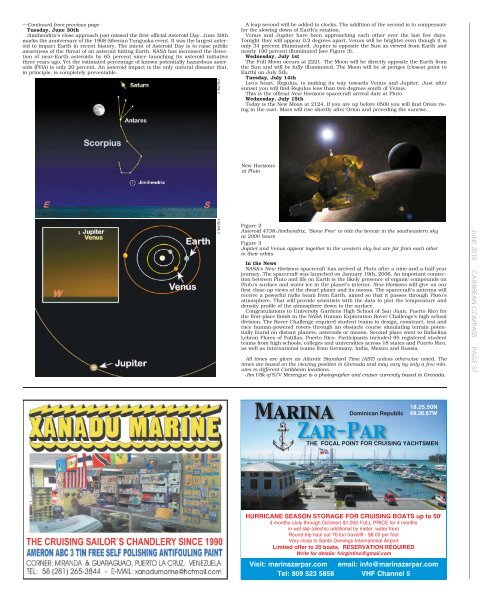Caribbean Compass Yachting Magazine June 2015
Welcome to Caribbean Compass, the most widely-read boating publication in the Caribbean! THE MOST NEWS YOU CAN USE - feature articles on cruising destinations, regattas, environment, events...
Welcome to Caribbean Compass, the most widely-read boating publication in the Caribbean! THE MOST NEWS YOU CAN USE - feature articles on cruising destinations, regattas, environment, events...
You also want an ePaper? Increase the reach of your titles
YUMPU automatically turns print PDFs into web optimized ePapers that Google loves.
— Continued from previous page<br />
Tuesday, <strong>June</strong> 30th<br />
Jimihendrix’s close approach just missed the first official Asteroid Day. <strong>June</strong> 30th<br />
marks the anniversary of the 1908 Siberian Tunguska event. It was the largest asteroid<br />
to impact Earth in recent history. The intent of Asteroid Day is to raise public<br />
awareness of the threat of an asteroid hitting Earth. NASA has increased the detection<br />
of near-Earth asteroids by 65 percent since launching its asteroid initiative<br />
three years ago. Yet the estimated percentage of known potentially hazardous asteroids<br />
(PHA) is only 20 percent. An asteroid impact is the only natural disaster that,<br />
in principle, is completely preventable.<br />
FIGURE 2 FIGURE 3<br />
A leap second will be added to clocks. The addition of the second is to compensate<br />
for the slowing down of Earth’s rotation.<br />
Venus and Jupiter have been approaching each other over the last few days.<br />
Tonight they will appear 0.2 degrees apart. Venus will be brighter even though it is<br />
only 34 percent illuminated. Jupiter is opposite the Sun as viewed from Earth and<br />
nearly 100 percent illuminated (see Figure 3).<br />
Wednesday, July 1st<br />
The Full Moon occurs at 2221. The Moon will be directly opposite the Earth from<br />
the Sun and will be fully illuminated. The Moon will be at perigee (closest point to<br />
Earth) on July 5th.<br />
Tuesday, July 14th<br />
Leo’s heart, Regulus, is making its way towards Venus and Jupiter. Just after<br />
sunset you will find Regulus less than two degrees south of Venus.<br />
This is the official New Horizons spacecraft arrival date at Pluto.<br />
Wednesday, July 15th<br />
Today is the New Moon at 2124. If you are up before 0500 you will find Orion rising<br />
in the east. Mars will rise shortly after Orion and preceding the sunrise.<br />
New Horizons<br />
at Pluto<br />
Figure 2<br />
Asteroid 4738 Jimihendrix, ‘Stone Free’ to ride the breeze in the southeastern sky<br />
at 2000 hours<br />
Figure 3<br />
Jupiter and Venus appear together in the western sky but are far from each other<br />
in their orbits<br />
In the News<br />
NASA’s New Horizons spacecraft has arrived at Pluto after a nine-and-a-half-year<br />
journey. The spacecraft was launched on January 19th, 2006. An important connection<br />
between Pluto and life on Earth is the likely presence of organic compounds on<br />
Pluto’s surface and water ice in the planet’s interior. New Horizons will give us our<br />
first close-up views of the dwarf planet and its moons. The spacecraft’s antenna will<br />
receive a powerful radio beam from Earth, aimed so that it passes through Pluto’s<br />
atmosphere. That will provide scientists with the data to plot the temperature and<br />
density profile of the atmosphere down to the surface.<br />
Congratulations to University Gardens High School of San Juan, Puerto Rico for<br />
the first-place finish in the NASA Human Exploration Rover Challenge’s high school<br />
division. The Rover Challenge required student teams to design, construct, test and<br />
race human-powered rovers through an obstacle course simulating terrain potentially<br />
found on distant planets, asteroids or moons. Second place went to Rafaelina<br />
Lebron Flores of Patillas, Puerto Rico. Participants included 95 registered student<br />
teams from high schools, colleges and universities across 18 states and Puerto Rico,<br />
as well as international teams from Germany, India, Mexico and Russia.<br />
All times are given as Atlantic Standard Time (AST) unless otherwise noted. The<br />
times are based on the viewing position in Grenada and may vary by only a few minutes<br />
in different <strong>Caribbean</strong> locations.<br />
Jim Ulik of S/V Merengue is a photographer and cruiser currently based in Grenada.<br />
JUNE <strong>2015</strong> CARIBBEAN COMPASS PAGE 37<br />
Marina<br />
Zar-Par<br />
Dominican Republic<br />
18.25.50N<br />
69.36.67W<br />
THE FOCAL POINT FOR CRUISING YACHTSMEN<br />
HURRICANE SEASON STORAGE FOR CRUISING BOATS up to 50'<br />
4 months (July through October) $1,000 FULL PRICE for 4 months<br />
in wet slip (electric additional by meter, water free)<br />
Round trip haul out 70 ton travelift - $8.00 per foot<br />
Very close to Santo Domingo International Airport<br />
Limited offer to 20 boats. RESERVATION REQUIRED<br />
Write for details: fvirgintino@gmail.com<br />
Visit: marinazarpar.com email: info@marinazarpar.com<br />
Tel: 809 523 5858 VHF Channel 5


















